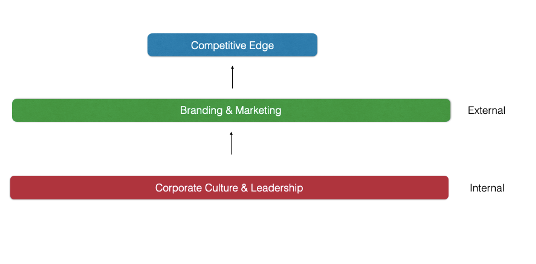The Indelible Marker: Stained leadership risks fewer talent referrals
A study by Gallup shows that “only four in ten employees agree that they know what their company stands for.”[1] Clarity from leadership around purpose and values is key. Together with empowerment and integrity, these components glue the organisation together and ensure a strong employer brand aligning human needs with business, culture and reputation.
- What are the pitfalls of a stained culture and employer brand?
- Why does leadership play a significant role in building and strengthening a company’s employer branding?
- How can you ensure strong leadership throughout your organisation to make a company and brand credible?
Trustworthiness from the inside out
Traditionally when thinking about employer branding, it is often associated with pure marketing gigs to create a buzz and attract talent without having reflected on the entire employee experience journey.
If what is proposed externally, the employer value proposition, is not aligned with the culture and what is actually happening internally, talent will not only experience the mismatch, but they will also feel long term deception. Like Titanic, your company will soon sink if you do not respect and align the corporate culture with what is projected in public. In other words, what happens on the inside, is reflected on the outside – regardless of how strong your marketing is. This will always impact your competitiveness:

Throughout history, many companies have burnt their fingers in the competitive market due to such a mismatch and today more than ever – given the easy access and existence of information and platforms like Glassdoor where companies are clearly rated for their employer brand by (potential) employees – the employer brand can strongly influence the popularity and success of companies.
Walk the talk
Authentic leadership is one of the key components of a healthy and successful company culture.
A German proverb when translated literally goes “The fish starts to stink from the head”. Seen figuratively, if the leader is not leading with integrity, is not acting as a role-model living both vision and values through actions, behaviour and talk, then the entire culture risks having a fatal impact on the durable success of the company.
Building trust and leading by example is however not as straight forward as one might think. Take today’s access to studies on company popularity amongst applicants and employees. A company can quickly move either up or down the Top 10 list for most appreciated employers – and just as quickly find itself in the Top 10 of worst employers to work for.
To give two contrasting examples, think of the popularity of Patagonia today. They are one of the most sought-after companies to work for thanks to their vision and values of creating a sustainable clothing brand and “using business to protect nature”[2]. Because they constantly instill their CSR strategy and the related values into their employee culture from the moment people are hired. They achieve this by weighing interests, values and volunteer work as highly as professional competencies throughout the employee journey and beyond, thus encouraging the same values outside work and giving employees time to live the values and common interests. Leadership, including shareholders, supports and lives the strategy and vision to the fullest and the ethical vision is constantly measured in terms of environmental impact, labour conditions and animal welfare.[3]
In contrast, among the top 20 most-hated companies, you find the media organisation Vice Media. While it has been a disruptive force in digital news content, it has experienced a severe PR crisis impacting not only its popularity among customers, but even more so its loyalty and trust of employees resulting in a highly damaged employer branding. The crisis of accusations of a toxic culture of sexism and sexual harassment was found to be mainly permitted and carried out by senior company employees, leading to the suspension of the president and the chief digital officer. A clear case of how poor and unethical leadership can break a brand – both in the market and in the “war for loyal and committed talent”. An indelible stain on leadership with a high price to pay; it will take a long time to recover from this negative impact.
With these two examples in mind, let’s look at the role of leadership and how to build it at all levels within the organisation.
Five levels of leadership
One mistake that is often made is to assume that leaders are only at the top of an organisation or in certain positions. While managers are easy to identify thanks to their titles and positions, (informal) leaders are everywhere and come in many shapes & sizes. To name a few, they can be employees active in charities and associations outside the company, they can be employees influencing teams, projects or committees within the company. While they are sometimes obvious to spot, sometimes such informal leaders are less prominent, yet they can all have a lasting impact on both internal and external stakeholders.
For this reason, it is important to support the growth of everyone’s leadership along the way. To help them not only to become a person with a title, but also a person of integrity and inspiration, a trusted support and advisor within the organisation as well as within the industry and even beyond.
In the long run, this will help the company to position itself and will impact the internal culture at all three levels[4]of the company culture, as well as the external projection in the employer branding.
Inspired by the model of 5 levels of leadership by John C Maxwell, it is imperative to look at the following levels of leadership maturity when building your brand as a leader – impacting the culture and (employer) brand of the company:
- Position
- Permission
- Production
- People development
- Pinnacle
1. Position yourself as a leader
2. Permission to lead through trust
Positional leaders often focus on serving themselves or their organisation, with too little regard for others. However, leaders who move up to level 2 shift their focus from me to we.[5] At this stage a leader builds on relationships under the motto “You can like people without leading them, but you cannot lead people well without liking them”.[6] The relation is built on trust and personal interaction
3. Production and results, not potential
At level 3, leaders walk the talk, perform, and show the way to productivity. “Their leadership talk is supported by their walk. They deliver results… They lead by example.”[7]
4. People development and empowerment
5. The pinnacle of respect and legacy:
Leading with integrity to empower to engage
With the 5 maturity levels of leadership in mind, it is important to remember that every employee need not be on the same level. This is what makes it so challenging to keep moving up the levels requiring consistent growth.
Despite this and with reference to the maturity level “position”, leaders often remain at this stage for too long harming their own growth and that of both team-members and the general organisation.
In this context, it is all the more interesting to learn from a Gallup poll of over one million workers in the US, that the number one reason why workers quit was in order to leave a bad manager, with 75% of those who left doing so because of their boss and not the job itself.[10]
This not only has a negative influence on the immediate team members, it throws a bad light on the organisation’s employee experience which again automatically impacts the employer branding.
As a manager and/or leader it is always important to reflect on one’s human connections and cultural impact on an individual, team and at organisational level. It is essential to keep all cultural levels in mind with a focus on respectfully building trusting relationships and taking understandable decisions based on clear values and purpose. This also empowers team members to grow and advance by leading with integrity.
Only through mature leadership is it possible to build a sustainable organisation with a culture of empowered, committed and engaged employees. This will automatically catalyse popularity and reputation creating a “high-end” employer branding.
To conclude a company’s reputation is only as authentic as its leadership, which is only as strong as the team that stands behind it. As the Afghan proverb goes:
“If you think you’re leading, but no one is following, then you are only taking a walk.”
Let us help you
[1] https://www.gallup.com/workplace/317867/leaders-control-employment-brand.aspx [04.05.2021]
[2] https://nailted.com/blog/4-examples-of-companies-with-great-employer-branding/ [25.09.2021]
[3] https://goodonyou.eco/how-ethical-is-patagonia/ [25.09.2021]
[4]Three levels of cultural change: Organisational, Team and individual, see Framework online: https://www.dev.mindforest.com/what-titanic-can-teach-us-about-employer-branding-and-company-culture/?lang=en [19.07.2021]
[5] John C. Maxwell, 2011 : “The 5 Levels of Leadership”, p. 87
[6] John C. Maxwell, 2011: “The 5 Levels of Leadership”, p.8
[7] John C. Maxwell, 2011: “The 5 Levels of Leadership”, p. 135
[8] John C. Maxwell, 2011: “The 5 Levels of Leadership”, p. 9
[9] Quote from Walter Lippmann
[10] https://www.workstars.com/recognition-and-engagement-blog/2020/03/19/why-employees-quit-11-evidence-based-reasons/ [04.06.2021]
WANT TO RECEIVE OUR LATEST THOUGHT LEADERSHIP CONTENT?
Related posts
 Digital Transformation and Change Management: Lessons shared in an event hosted by Cebi and MindForest
Digital Transformation and Change Management: Lessons shared in an event hosted by Cebi and MindForest
 Can Engagement Help Reduce Absenteeism?
Can Engagement Help Reduce Absenteeism?
 Daring to Lead Positive Transformation: What If you explored a disruptive approach to Change with Appreciative Inquiry?
Daring to Lead Positive Transformation: What If you explored a disruptive approach to Change with Appreciative Inquiry?
 Have you Examined the Advantages of Working with Data Analytics yet?
Have you Examined the Advantages of Working with Data Analytics yet?
 Daring to Lead Positive Transformation: How can you implement and manage positive change with success?
Daring to Lead Positive Transformation: How can you implement and manage positive change with success?




